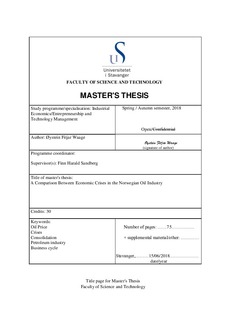A Comparison Between Crises in the Norwegian Oil Industry
Master thesis

View/
Date
2018-06-15Metadata
Show full item recordCollections
- Studentoppgaver (TN-ISØP) [1468]
Abstract
The discovery of oil on the Norwegian continental shelf in 1969 ushered an industry that would become the most important industry in Norway. The government created fiscal regimes that would secure the national interests in production of this resource.
Over the course of the last 35 years there have been several crises in the Norwegian industry. 1986, 1998, 2008 and 2014 are the years when four of the most pronounced oil crises in was initiated. The objective of this thesis is to analyze and compare the historical and most recent oil crises in the Norwegian petroleum industry. The aim is to reveal causes and similarities, how the crises manifested in the Norwegian industry and what was done to mitigate the crises.
The bust in oil prices in 1986 was caused by OPEC’s price manipulation. This was the first substantial drop in oil prices ever experienced on the Norwegian continental shelf. This prompted the Norwegian government to revise the fiscal regime and make the shelf more accessible for foreign companies.
In 1998, the global consumption of oil fell, causing an over-supply of oil in a period when the activity on the continental shelf was high. To mitigate the crisis that emerged from the combination of high costs and low a low oil price, the industry moved towards a higher degree of cooperation through mergers, a commitment to new industry standards and new contract formats that where based more on the long-term cooperation. The large oil price drop in 2008 did not have a pernicious effect on the Norwegian petroleum industry as this crisis affected most parts of the global economy, and the oil price increased fairly rapidly. From June 2014, the oil price fell from 110 to 34 dollars per barrel over the course of 1 year and 6 months. This fall in prices was driven by the surge in production of non-conventional shale oil in the America, followed by an increased supply from OPEC. The industry had for the years leading up to the crises experienced large increases in drilling costs, and cost overruns when developing new fields.
The Norwegian petroleum industry has been subject to multiple changes in fiscal framework and organizational structures. Also, the industry has been driven by substantial technological developments. Substantial changes in the industry has, for the most part been driven by periods of low profitability for companies producing oil on the Norwegian Continental Shelf. Some fundamental developments in the industry creates important differentiations between historical crises in the Norwegian Continental Shelf. The overarching theme is that the potential for development on the continental shelf is diminishing. This has contributed to increase the effects of the recent crisis in 2014.
The main findings in this thesis is that crises in the Norwegian petroleum industry have been preceded by a period of high activity and large cost overrun that amplify the crises. The largest manifestation of the crises has been the reduction in invested capital. The moves that have been made to mitigate the crises have largely been consolidation, increased cooperation between companies and commitment to industry standards.
Description
Master's thesis in Industrial Economics